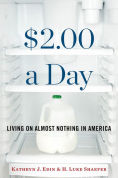In 1980 a pair of newlyweds, fresh out of college, left the suburbs to begin an urban ministry in a blighted neighborhood in Baltimore. Naive and earnest, already expecting a child, they wanted to bring hope to at least a corner of this city where great wealth and great poverty existed side by side.
I, too, moved to Baltimore in 1980, moved back, despite my vows never to return after leaving in 1968, the year Robert Kennedy and Martin Luther King, Jr. were killed, the year Baltimore erupted in riots whose wounds have still not healed. I couldn’t bear the racism, some overt, some more subtle, much of it structured into the way the city worked.
I ended up living just a few blocks from the Garriotts, though I didn’t know it then. Although I’d grown up in a prosperous neighborhood, I’d spent many of the intervening years as a single parent on welfare, finding my footing in a world that was foreign to me.
Maria writes movingly of her journey, which was similar to mine: coping with culture shock and learning to find the value in everyone, even the people we’d been taught to despise, while resisting the temptation to sentimentalise the poor. The house they bought had several apartments, which left them sometimes sharing a home with addicts and prostitutes, and people who heard voices. They struggled to find funding to support their work.
Everywhere we turned we saw needs: children lacking supervision and healthy activities after school; youths standing idle for want of jobs and job training, dropouts needing tutoring and G.E.D. classes; teenage mothers desperate for mentoring to break the cycle of poverty; drug addicts waiting months for scarce treatment slots.
What makes this memoir so important is its honesty. If you really want to know what life is like in a struggling urban neighborhood, this book is for you. You can’t rely on television dramas or news reports to tell you about that life; it is both better and worse than you think. Maria’s story is not a dewy-eyed romantic picture of helping the poor but rather a hard look at the day-to-day reality of living according to your beliefs.
Maria writes openly of the struggles she and her husband faced living in and ministering to a mostly African-American community. They were questioned by others, yes, but even more by themselves, always wondering if an African-American pastor would be better able to serve the community, welcoming recruits of all ethnicities and ages.
Maria shares the stories of many of these people: neighbors, members of the church, volunteers who helped with the ministry. She writes movingly of many of them, such as Steve Stahl who lived in one of their apartments, participated in their church, and suffered from schizophrenia and depression.
Even more strikingly, Maria shares her worries about the effect on her five children, growing up in such a neighborhood, being the only white children in school, watching their childhood friends die from guns or drugs.
I remember the earnest people I knew in college, who started and participated in programs to help those in poverty, both here and abroad. I also remember living in poverty myself and learning to tell who can help and who can’t. It is obvious that the Garriotts have made a difference, not just to the members of their church, but also to their neighborhood. Many of us have thoughts of helping others, but few truly live their beliefs as the Garriotts have.
Maria’s path is only one of many. There are lots of ways to make a difference. It doesn’t have to be a church. It can be working at a food kitchen or teaching poetry in prisons, mentoring a troubled youth or teaching in an urban school. It helps us all to learn about those who are doing such things. These stories remind us that there is good in the world and we can help to make it happen.
What true stories have you read that have inspired you?
Disclosure of Material Connection: I received a copy of this book free from the author. I was not required to write a positive review. The opinions I have expressed are my own.

